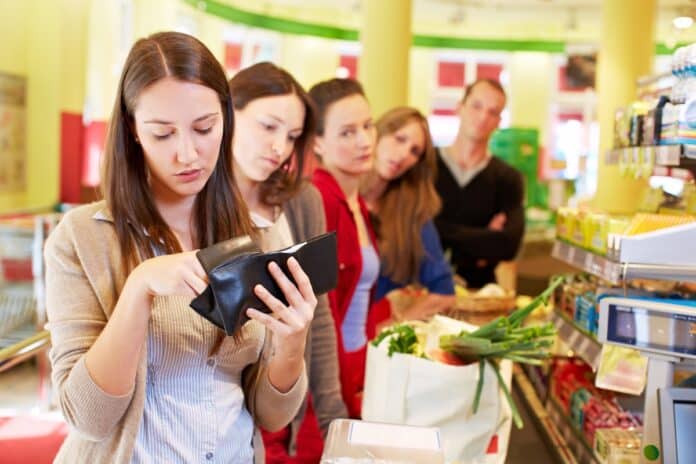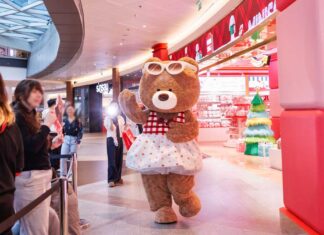Find out how much brick-and-mortar stores are losing money because they are still making customers wait in checkout lines.
New research by Zippin, a leading provider of checkout-free technology, reveals that the real cost of waiting in line at the store goes far beyond time wasted. In fact, 92 percent of retailers admit that wait times during busy periods have had a negative impact on their revenues. Based on these findings, designed to reveal the state of retail post-pandemic, Zippin calculates that retailers are facing a $555 billion headwind as a result of shoppers leaving checkout lines.
Shoppers Admit they Dont Tolerate Long Lines
More than half of the participants in a parallel consumer study stated that they have abandoned a store without making a purchase due to long lines in the past 12 months. Of these, 84% reported that they did this at least twice in the last year. The cause? 80% of shoppers claimed that they have had to stand in lines more frequently while shopping in retail stores since the pandemic.
Labor Shortages Cause Long Checkout Lines, Driving Down Revenue
Another major outcome of the pandemic has been the labor shortage caused by hundreds of thousands of frontline workers abandoning their jobs in favor of more rewarding, better-paid work. Hiring challenges have been largely responsible for unacceptable wait times at checkout.
Brick-and-mortar retailers still account for 85.2 percent of retail transactions according to the U.S. Department of Commerce, and their success or failure can have a huge impact on the economy. Over two-thirds of brick-and-mortar retailers said that the current tight labor market (where many find it hard to hire retail crew) is negatively impacting their revenues. This, combined with the resulting long wait times at the checkout line, is causing a double whammy for retailers’ bottom line.
Alice Chan, Senior Vice President of Marketing at Zippin:
As we face a highly unpredictable macro-economic climate, it is crucial that retailers don’t leave money on the table, especially after they have done the hard work of bringing shoppers through their doors. We have all asked ourselves: ‘shall I stay or shall I go?’ when we see just how long the checkout line is. The good news is that using tech to eliminate checkout lines will immediately unlock additional revenue and restore customer satisfaction. The frictionless economy is here.
Desperate Times Call for Strong Measures
Only 14 percent of retailers are planning to address the issues with additional hiring. Technology is the most favored solution with 79 percent planning to implement either self-checkout (47%) or checkout-free (32%) to win back consumers who are tired of friction-filled in-store experiences.
However, retailers have been slow to adopt retail technology to address these problems and instead, implemented closures and other restrictions that have further hit their bottom line, including:
- 45% have reduced opening hours (e.g. eliminating early or late shifts) on an ongoing basis.
- 41% have executed a short-term temporary closure (e.g. at least a few hours) of at least one of its stores.
- 26% have canceled expansion plans (e.g. the opening of a new store).
- 21% have permanently closed stores including 9% who have closed multiple stores.
Not all Lines are Created Equal
While consumers largely agree that long lines are unacceptable, Gen Z is more likely to quit because of a long line, with nearly three-quarters sharing they have left a store in the last year, compared to less than one-third of Baby Boomers.
Read more: Consumer Study: Who is Spending the Most during Inflation?
And there are certain purchases shoppers are less likely to wait in line for. Locations that need to serve consumers quickly, including stadiums and arenas, movie theaters, theme parks, and ski resorts, are regularly missing out on valuable revenue from concession stands:
- 31% are least likely to wait for drinks and snacks at places like movie theaters, theme parks, ski resorts, casinos, and hotels.
- 27% are least likely to wait for refreshments at a sporting event.
- 26% are least likely to wait for food/drink at a quick service restaurant.
There is also bad news for drug and convenience stores as over 36 percent of consumers say they are least likely to stand in line for non-edible everyday products such as non-edible everyday products e.g. sunscreen, shampoo, and batteries.
Brick and Mortar Stores Have to Embrace Technology Now
Krishna Motukuri, CEO and co-founder of Zippin, highlighted that retail technology has been proven to increase customer satisfaction, alleviate labor shortages and increase profits. Yet, some retailers have still been hesitant to adopt and as a result experienced their revenues decline.
Our research found that 100 percent of retailers have heard of checkout-free technology, with nearly three-quarters being very familiar with the concept. One-third say their company is going to introduce checkout-free to reduce in-store customer wait times. While this is great news, time is of the essence. Those who adopt frictionless retail now, will reap the competitive advantages and have staying power in this tough economy.
Zippin invited Drew University’s Associate Professor and Chair of Sociology Christopher Andrews, to review its research and comment on the findings. He noted:
The fact that almost 30 percent of consumers stated they dislike self-checkout is an important message for retailers to hear. With so many deploying self-checkout kiosks to address long lines, they should realize that they are effectively turning away this group of shoppers and saying goodbye to yet more revenue.
There is a cure for retailers’ post-pandemic hangover, and it’s within their grasp. Technology is designed to alleviate the pressure on the bottleneck caused by checkout. Consumers are voting with their feet and their wallets and leaving stores built around the tyranny of barcode scanning devices and cash registers.
Research Methodology
Zippin commissioned market research company 3Gem to survey 1,000 U.S. consumers and 100 decision-makers at retailers across the country. The survey was conducted between December 21, 2022 and January 3rd, 2023.
About Zippin
Zippin has developed the next generation of checkout-free technology, enabling retailers to quickly deploy frictionless shopping in their stores. Their patent-pending approach uses AI, machine learning, and sensor fusion technology to create the best consumer experience, banishing checkout lines and self-scanners for good, and letting shoppers zip in and out with their purchases.
Zippin’s technology is being used by retailers on four continents to power checkout-free experiences in their street-front retail stores, as well as stores, kiosks, and concession stands in a wide variety of venues such as stadiums, offices, airports, train stations, hotels, convention centers, and residential buildings.
For more information, visit https://www.getzippin.com.









